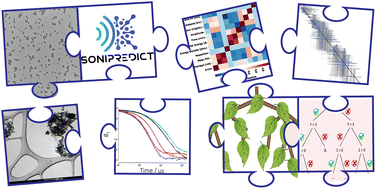Designing the ultrasonic treatment of nanoparticle-dispersions via machine learning†
Abstract
Ultrasonication is a widely used and standardized method to redisperse nanopowders in liquids and to homogenize nanoparticle dispersions. One goal of sonication is to disrupt agglomerates without changing the intrinsic physicochemical properties of the primary particles. The outcome of sonication, however, is most of the time uncertain, and quantitative models have been beyond reach. The magnitude of this problem is considerable owing to fact that the efficiency of sonication is not only dependent on the parameters of the actual device, but also on the physicochemical properties such as of the particle dispersion itself. As a consequence, sonication suffers from poor reproducibility. To tackle this problem, we propose to involve machine learning. By focusing on four nanoparticle types in aqueous dispersions, we combine supervised machine learning and dynamic light scattering to analyze the aggregate size after sonication, and demonstrate the potential to improve considerably the design and reproducibility of sonication experiments.



 Please wait while we load your content...
Please wait while we load your content...